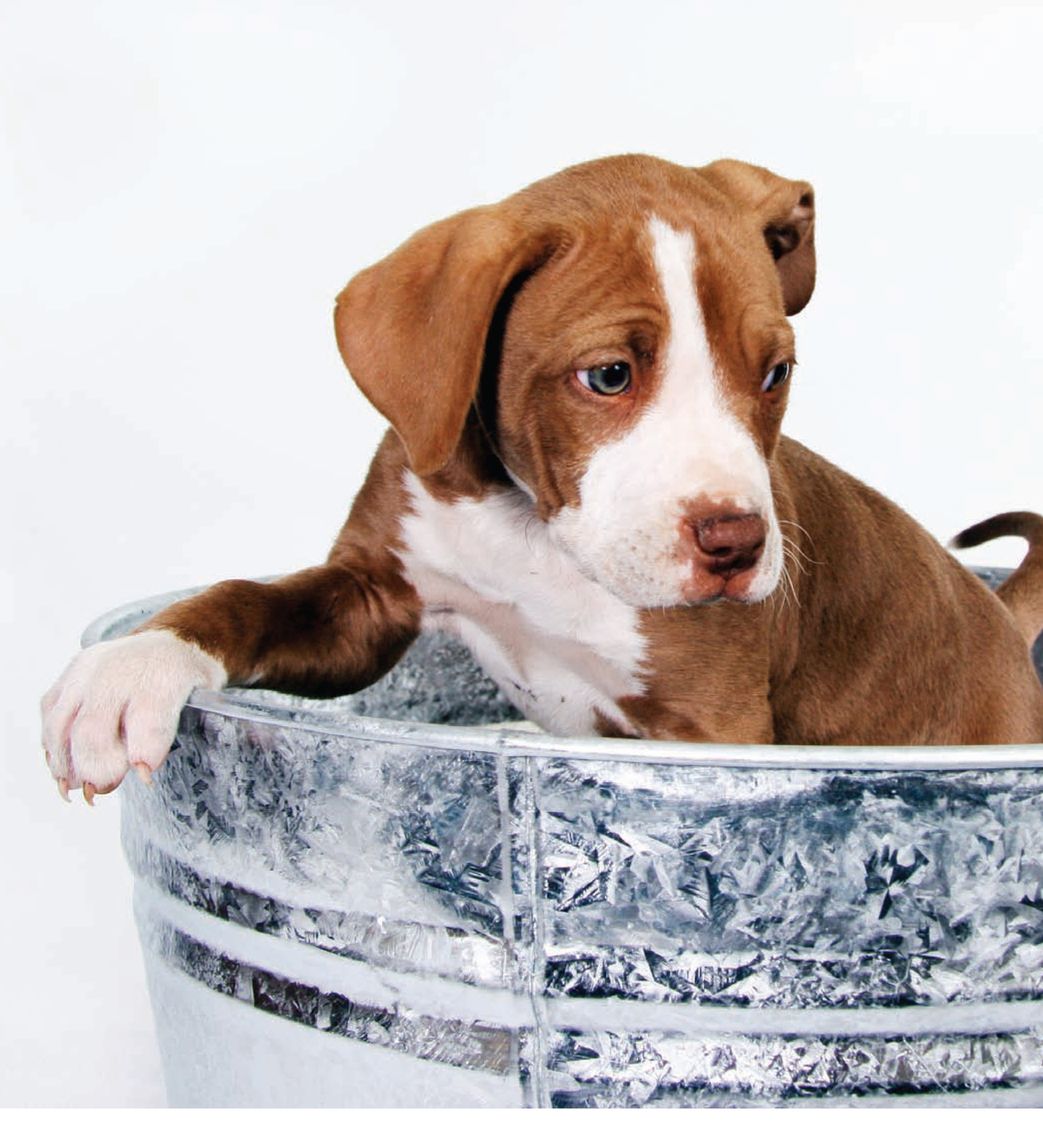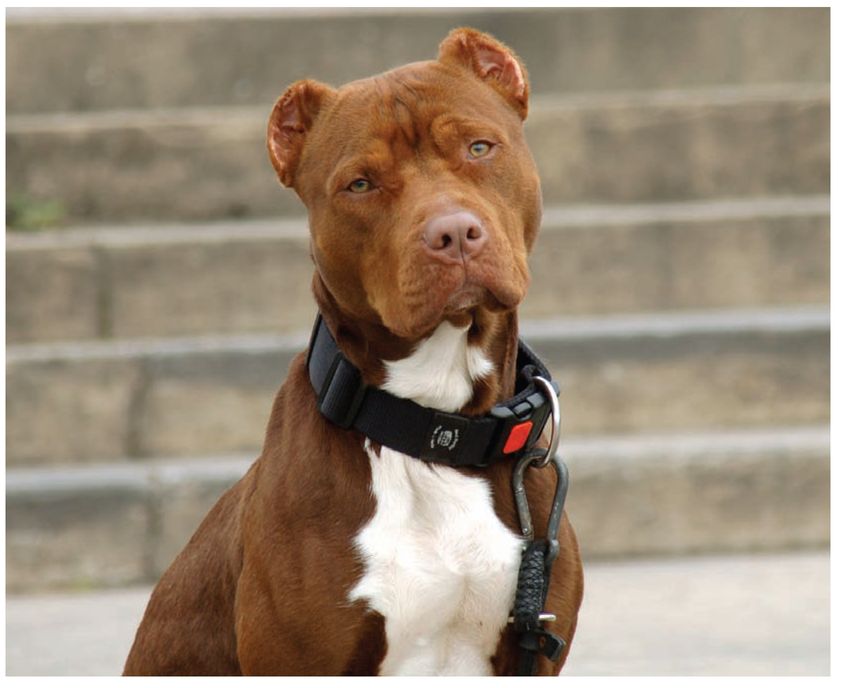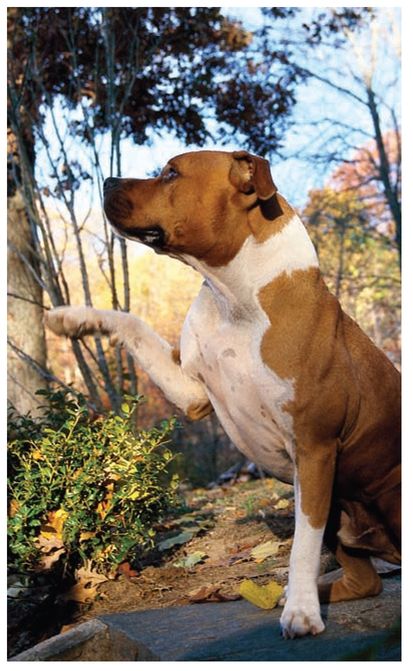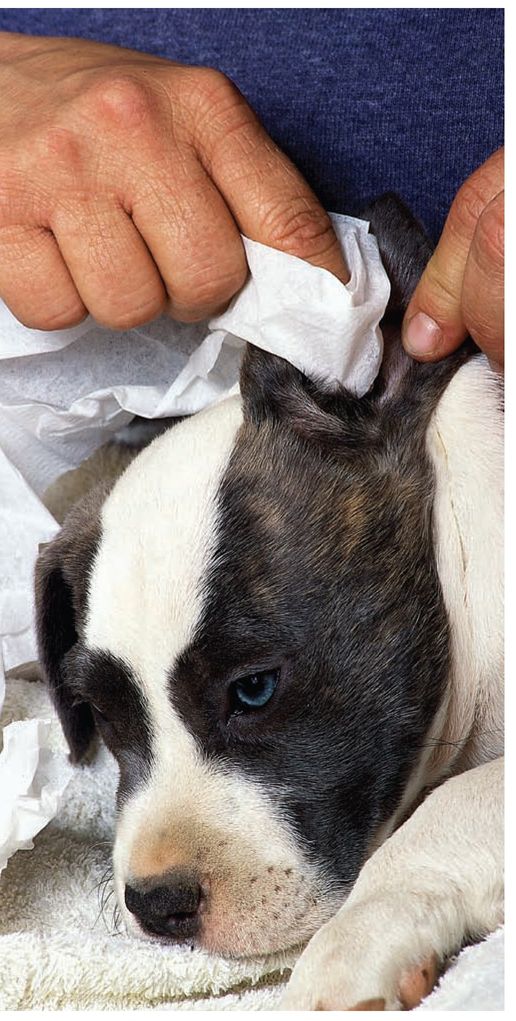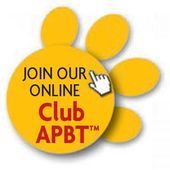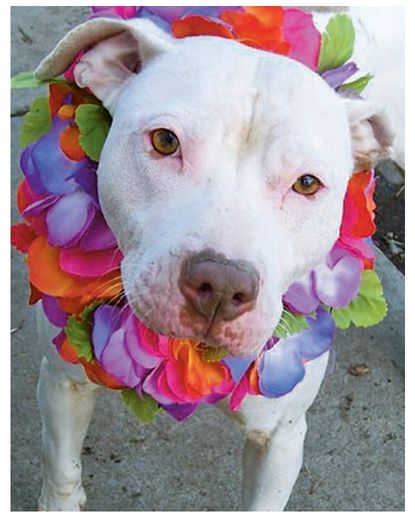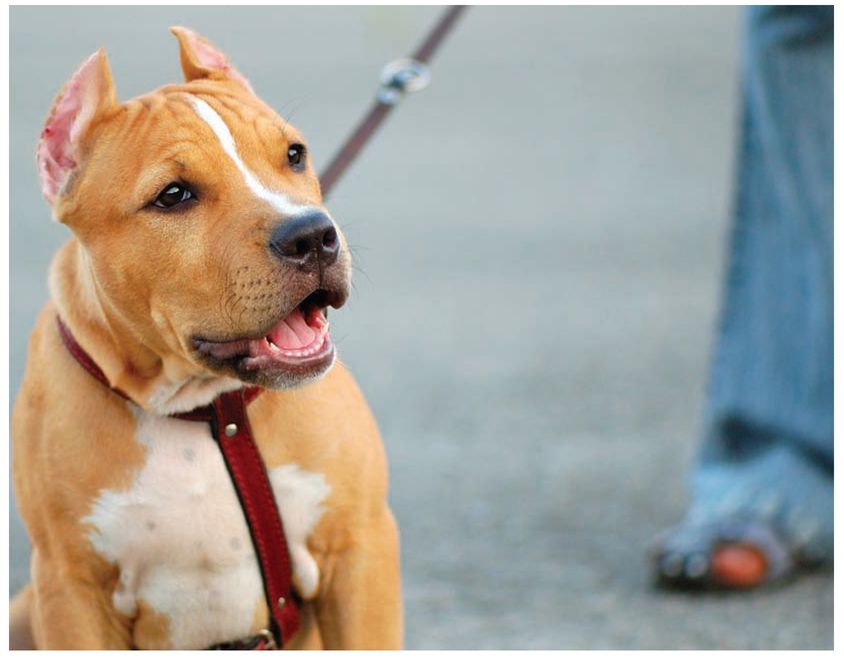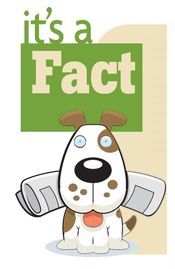CHAPTER 9
BULLY BREED GROOMING GUIDE
When it comes to wash-and-wear breeds, the American Pit Bull Terrier tops the list as naturally fancy, sparkly and eye catching. Pit bulls don’t require very much grooming, and the majority of their coat problems stem from a poor diet. Producing a healthy, glossy coat starts from the inside. Every dog’s nutritional needs are slightly different, but coat dressing can never replace the natural shine that comes from good nutrition and good health.
No matter what the television commercial models with long, flowing tresses tell you, the ingredients you add externally to your dog’s hair will not change a brittle, lifeless coat into a soft, healthy coat. The truth is that if you want your APBT to have a healthy coat, you need to take a close look at your dog’s nutrition. Healthy hair and skin begins with good nutrition.
A good premium dog food is the best place to start growing a healthy coat. Your pit bull’s diet is not the place to economize. Purchase the best food you can afford and resist the impulse to save money at your APBT’s expense. Pit bulls’ skin can be sensitive, so consult your veterinarian when choosing your dog’s food. Once you’ve established a good nutritional basis, you can move on to improving the coat from the outside.
Nail clipping can be tricky, so many dog owners leave the task to the professionals. However, if you walk your dog on concrete, you may not have to worry about it. The concrete acts like a nail file and will probably keep the nails in check.
However, sometimes a dog, especially a playful APBT, gets dirty and needs to be gussied up. Here’s how you do it.
GEAR UP
In order to keep a pit bull polished, a smart owner will need a few essential grooming tools:
• a pair of nail clippers
• styptic powder
• cotton balls
• ear powder or cleaner
• tearless pet shampoo
• a coat conditioner
• hydrogen peroxide or baby wipes
• a bristle brush or a slicker brush
LATHER, RINSE, REPEAT
American Pit Bull Terriers only need to be bathed once every eight weeks or so — or when they find a mud puddle to their liking. Bathing them too often removes natural oils from the coat. Some groomers prefer a high-quality medicated shampoo, which helps keep the skin in better condition, while many breeders avoid products containing tea tree oil.
Kim Swogger, a breeder in Wampum, Pa., sticks to natural shampoos. “This breed is known to have sensitive skin, and some pit bulls can be prone to skin problems. I like oatmeal shampoo. I would definitely stay away from generic, economy brands, but any shampoo can dry the skin if you use it too often.”
A smart owner knows that keeping a pit bull beautiful starts with a healthy diet. Don’t skimp; buy the best.
After removing a tick, clean your dog’s skin with hydrogen peroxide. If Lyme disease is common where you live, have your veterinarian test the tick. Tick preventative medication will discourage ticks from attaching and kill any that do.
— groomer Andrea Vilardi from West Paterson, N.J.
American Pit Bull Terriers do not require much grooming to look fantastic. To give your already clean pit bull an extra glow, give him a rubdown with a chamois cloth or towel in addition to your already scheduled grooming routine.
Washing, rather than scrubbing, the coat minimizes the possibility of stripping coat oils or irritating sensitive skin. After completely wetting your dog, saturate a large bath sponge with shampoo and gently glide it over the entire coat. Do not pour the shampoo directly onto your dog. Work in the direction of the hair growth and do not rub or scrub. Rinse and repeat. A conditioning rinse is not recommended because it may soften the coat’s natural texture. The final rinse should leave the coat squeaky clean. Make sure that no soap residue remains in the coat. If your dog’s skin seems itchy or flaky the day after a bath, this is often due to inadequate rinsing.
The key to a successful bath is organization. Keep all your grooming tools in a basket so you can set up for the bath in only a moment. (This is handy when your zestful terrier finds something interesting in the yard to roll in and you must move quickly!)
Check the temperature of the water against the inside of your wrist or with your hand. Hold the hose close to your dog’s body to eliminate excessive spray. If you don’t have a hose attachment, use a plastic cup to scoop water and pour it over your dog.
Work from the highest point to the lowest on your pit bull with the water and shampoo; use your fingers to work the shampoo throughout the coat.
To keep water from getting into your dog’s nose when you rinse this area, hold your hand as a barrier around the nose, and let the water flow from behind the ears toward your hand and sort of break against the hand. Rinse your dog with a gentle flow of water until his coat feels clean and the water runs clear.
When drying the coat, use a blotting technique, squeezing the hair instead of rubbing the towel back and forth. If you use a hair dryer, test the air flow against the inside of your wrist first, then hold it about 10 to 12 inches from the dog.
BRUSH THAT DOG!
Regular brushing, at least once a week, also contributes to healthy skin. Using a natural bristle brush or a slicker brush, brush the entire coat in firm, circular motions to loosen dead hair, stimulate the skin and increase the production of natural coat oils.
American Pit Bull Terriers require minimal grooming and only need to be bathed about once every eight weeks.
At the end of every coat growth cycle, hair dies and leaves the coat looking dull and lifeless until dead hair is shed and new growth emerges. Frequent brushing speeds up the process and stimulates regrowth from each hair follicle.
American Pit Bull Terriers shed minimally year-round and may experience pronounced seasonal shedding in the spring and fall. Seasonal shedding is more evident in climates with definite seasons because light has a big effect on coat growth. The seasonal coat change is more pronounced in outdoor dogs. Indoor dogs tend to have more year-round shedding. Regular dog brushes really aren’t effective in either case because a pit bull’s coat is so short.
NOW EAR THIS
Whether your dog has cropped or natural ears, they should be checked frequently and cleaned at least once a week. Cropped ears permit better air circulation, but there is a bigger risk of water or debris getting into the ear canal. Ear infections can become serious before you notice anything is wrong.
Symptoms of an ear problem include sensitivity to touch, heavy buildup of wax and debris, inflammation, odor, head shaking and scratching, or head tilting. Bacterial, fungal or yeast infections may also require specific veterinary treatment.
Moisture is a major source of infection; you can put cotton in your dog’s ears before a bath to prevent water from getting into the ear canals. Ears should always be swabbed and dried carefully after swimming or bathing.
Every American Pit Bull Terrier should look dapper. What do you need to keep your dog looking his best? Go to Club APBT (
DogChannel.com/Club-APBT) and download a checklist of essential grooming equipment you and your pit bull will need.
The canine ear canal makes an abrupt turn near the jaw, creating an ideal setting for infections. Ear-cleaning solution not only helps flush out debris, it also alters the ear’s pH levels to discourage infection. Squirt enough ear-cleaning solution into your dog’s ear to fill the canal and gently massage the opening for a few seconds to loosen debris. Use a cotton ball to wipe away all visible moisture, earwax and dirt.
The family pet shouldn’t be the center of a power struggle between children and parents. Divvy up grooming responsibilities early on, and make the issue non-negotiable. A clean pit bull is welcomed into the house with the family; a dirty one is banished to the backyard, doomed to be on the outside looking in. Even short-coated breeds such as APBTs need a regular grooming routine.
NAIL CLIPPING 4-1-1
Immediately after the bath is the best time to clip the nails because the water has softened the nails, and your APBT may be somewhat tired-out by the bath. Nail trimming is recommended every two weeks with nail clippers or a nail grinding tool. Short nails are crucial to maintaining the breed’s normal foot shape. Long nails will permanently damage dog’s feet, and the tight ligaments of round, arched feet will break down more quickly. If your dog’s nails are clicking on the floor, this is a sign that they need to be trimmed.
When grinding, use a low-speed (5,000 to 10,000 rpm), cordless nail grinder fitted with a fine grade (100 grit) sandpaper cylinder. Stone cylinders are more prone to heat buildup and vibration. Hold your dog’s paw firmly in one hand, spreading the toes slightly apart. Touch the spinning grinder wheel to the nail tip for one or two seconds without applying pressure. Repeat if necessary to remove only the nail tip protruding beyond the quick. Grinders have the added benefit of leaving nails smooth and free of sharp, jagged edges produced by traditional nail clippers.
Your APBT should be accustomed to having his nails trimmed from an early age, because it will be part of your maintenance routine throughout his life. Not only does it look nicer, but long nails can also unintentionally scratch someone. Furthermore, a long nail has a better chance of ripping and bleeding, or causing the feet to spread.
Before you start cutting, make sure you can identify the “quick” (the vein in the center of each nail). It will bleed if accidentally cut, which will be quite painful for your dog as it contains nerve endings. Keep some type of clotting agent on hand, such as a styptic pencil or styptic powder (the type used for shaving). This will quickly stop the bleeding when applied to the end of the cut nail. Do not panic if this happens; just stop the bleeding and talk soothingly to your dog. Once he has calmed down, move on to the next nail. It is better to clip a little at a time, particularly with black-nailed dogs.
Hold your pup steady as you begin trimming his nails; you do not want him to make any sudden movements or run away. Talk to him soothingly and stroke him as you clip. Holding his foot in your hand, simply take off the end of each nail in one quick clip. You can purchase nail clippers that are specifically made for dogs; you can probably find them wherever you buy grooming supplies.
There are two predominant types of clippers. One is the guillotine clipper, which is a hole with a blade in the middle. Squeeze the handles, and the blade meets the nail and chops it off. It sounds gruesome, and for some dogs, it is intolerable. Scissor-type clippers are gentler on the nail. Just make sure the blades on either of these clippers are sharp. Once you are at the desired length, use a nail file to smooth the rough edges of the nails so they don’t catch on carpeting or debris outdoors.
If the procedure becomes more than you can deal with, just remember: Groomers and veterinarians charge a nominal fee to clip nails. By using their services you won’t have to see your dog glower at you for the rest of the night.
When inspecting feet, you must check not only the nails but also the pads of the feet. Take care that the pads aren’t cracked and always check between the pads to be sure that nothing has become lodged there. Depending upon the season, there may be a danger of grass seeds or thorns becoming embedded, or even tar from the road getting stuck. Butter, by the way, is useful to help remove tar from your pit bull’s feet.
The crunchiness of dry dog food helps keep teeth healthy and shiny by reducing plaque accumulation.
FLASH THOSE PEARLY WHITES
Like people, American Pit Bull Terriers can suffer from dental disease, so experts recommend regular teeth cleaning. Daily brushing is best, but your dog will benefit from a thorough teeth cleaning a few times a week. His teeth should be white and free of yellow tartar, and the gums should appear healthy and pink. Gums that bleed easily when you perform dental duties may have gingivitis.
The first thing to know is that your dog probably isn’t going to want your fingers in his mouth. Desensitizing your pit bull — getting him to accept that you’ll be looking at and touching his teeth — is the first step to overcoming his reticence. You can begin this as soon as you get your dog, with the help of something that motivates him most: food.
For starters, let your APBT lick some chicken, vegetable or beef broth off your finger. Then, dip your finger in broth again, and gently insert your finger in the side of your dog’s mouth. Touch his side teeth and gums. Several sessions will get your dog used to having his mouth touched.
Use a toothbrush specifically made for a dog or a finger-tip brush wrapped around your finger to brush your American Pit Bull Terrier’s teeth. Hold the mouth with one hand, and brush with the other. Use toothpaste made specifically for canines with dog-slurping flavors like poultry and beef. The human kind froths too much and can give your dog an upset stomach. Brush in a circular motion with the brush held at a 45-degree angle to the gum line. Be sure to get the fronts, tops and sides of each tooth.
Good dental hygiene promotes fresh breath, promotes fresh breath, as well as a healthy heart.
Pay special attention to your APBT’s ears as they are a common site for infections.
Dogs can’t rinse and spit after a brushing, so dog toothpaste must be safe for pets to swallow. Always use a toothpaste specially formulated for dogs when brushing your APBT’s teeth.
Look for signs of plaque, tartar or gum disease, including redness, swelling, foul breath, discolored enamel near the gum line and receding gums. If you see these, take your dog to the veterinarian immediately. Also see your vet about once a year for a dental checkup.
SHOW GROOMING
If your American Pit Bull is destined for the show ring, you may opt for a few finishing touches. Every dog can benefit from a bit of detail work but minimal grooming is the rule to maintain the breed’s natural look. Your dog should be spotlessly clean, but the coat should feel smooth and stiff. Avoid shampoos that may soften the coat’s natural texture. Timing can also make a difference. Some coats look and feel their best two or three days after a bath.
Trimming should enhance your APBT’s smooth outline. Stray hairs can be removed from the outline of body, tip of tail and along the edges of cropped ears with thinning shears. Work slowly and stop frequently to evaluate the results. Don’t overdo it or leave tell-tale straight lines or scissor marks in the coat. Whisker trimming is optional.
REWARD A JOB WELL DONE
Rewarding your pet for behaving during grooming is the best way to ensure stress-free grooming. Bathing energizes your pet, so using the time immediately after grooming to play is the best way to reward your pit bull for a job well done. Watching your clean, healthy APBT race from room to room out of sheer joy is your reward for being a smart owner!

TRY THIS
Six Tips for APBT Care
1. Grooming tools can be scary to some dogs, so let yours see and sniff everything at the onset. Keep your beauty sessions short, too. Most bully breeds don’t enjoy standing still for too long.
2. Look at your dog’s eyes for any discharge, and his ears for inflammation, debris or foul odor. If you notice anything that doesn’t look right, contact your veterinarian ASAP.
3. Choose a time to groom your dog when you don’t have to rush, and assemble all of the grooming tools before you begin. This way, you can focus on your dog’s needs instead of having to stop in the middle of the session.
4. Start establishing a grooming routine the day after you bring him home. A regular grooming schedule will make it easier to remember what touch-up tasks your dog needs.
5. Proper nail care will help with your dog’s gait and spinal alignment. Nails that are too long can force a dog to walk improperly. Also, extra-long nails can snag and tear, causing painful injury to your American Pit Bull Terrier.
6. Good dental health prevents gum disease and early tooth loss. Brush your APBT’s teeth daily and see a veterinarian yearly.
Six Questions to Ask a Groomer 1. Do you cage dry? Are you willing to hand dry or air dry my pet?
2. What type of shampoo are you using? Is it tearless? If not, do you have a tearless variety available for use?
3. Will you restrain my dog if he acts up for nail clipping? What methods do you use for difficult dogs?
4. Are you familiar with the American Pit Bull Terrier breed? Do you have any references from other pit bull owners?
5. Is the shop air-conditioned during hot weather?
6. Will my dog be getting brushed or just bathed?
